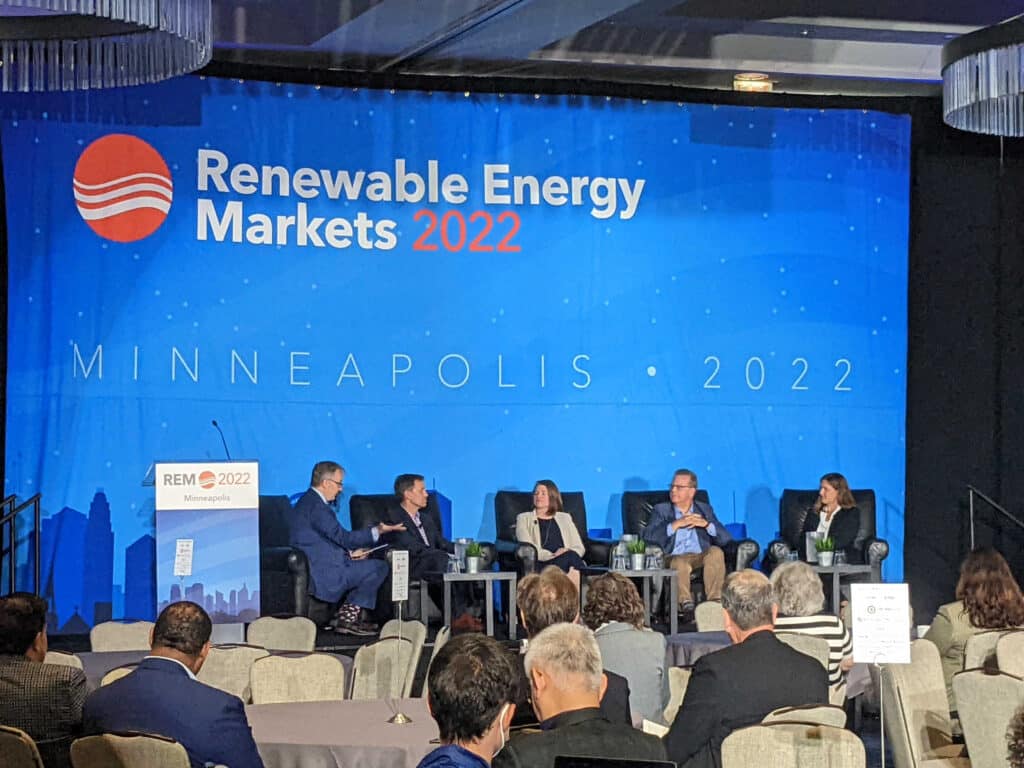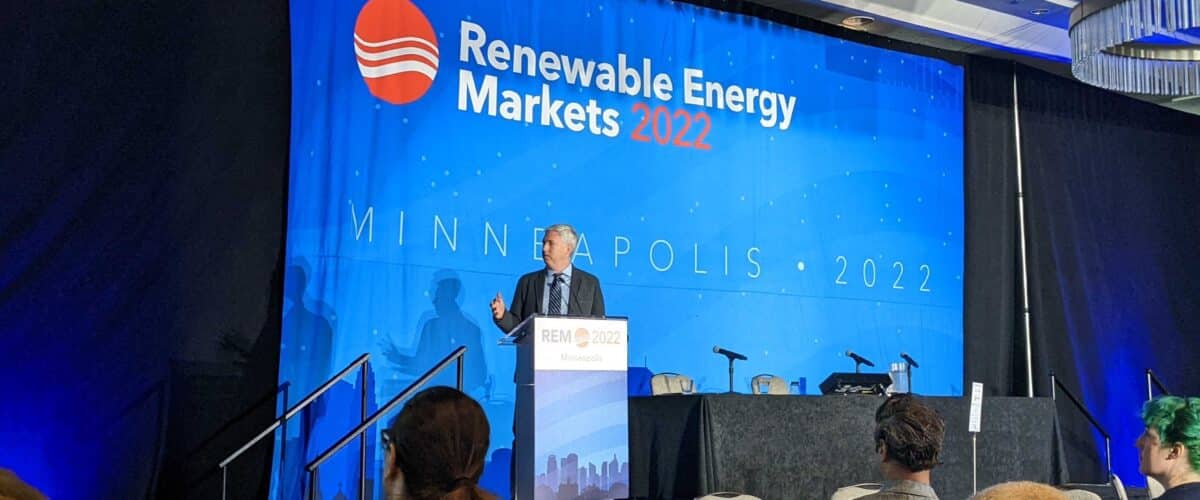Last month, 3Degrees showed up in full force at the annual Renewable Energy Markets Conference, one of the industry’s most important clean energy events. The event focuses on the states, businesses, organizations and households that choose clean electricity. Each year, industry professionals gather for REM to understand emerging policy trends, exchange market best practices, and gain new tools to excel in retail renewable energy markets.
The Center For Resource Solutions (CRS) hosted this year’s conference, in which themes like green hydrogen, the Inflation Reduction Act, 24/7 carbon-free energy (CFE) procurement, and more were discussed. A personal highlight was participating in a panel discussion on the impact of corporate renewable energy procurement and the various pathways to achieve certain goals alongside other panelists from T-Mobile and the Clean Energy Buyers Association (CEBA).

Participants on the “Power Table” panel joined in a lively and informative conversation about the highly dynamic landscape for renewable energy markets and market growth opportunities.
With two jam-packed days of expansive content, it was nearly impossible to attend every session, but our team made a concerted effort to spread out and cover a variety of topics and we’ve collected our key takeaways below.
Innovative Approches to Procurement
My dialogue with CEBA and T-Mobile on the panel “Impact of Corporate Renewable Energy Procurement: Different Pathways to Achieving Goals,” focused on how corporations are approaching their renewable energy purchasing decisions in terms of impact. The dialogue touched on the diverse types of buyers pursuing these goals (in terms of MWh needs, level of internal expertise, etc.), the pros and cons of certain procurement options, and future trends. A few points discussed during the panel included:
- Understanding the types of actions companies can take to drive more impactful procurement decisions, while remaining consistent with GHG accounting rules and RE 100 compliance.
- Focusing overall on efforts that accelerate grid decarbonization, such as prioritizing procurement at a more localized level where a company has load and where renewable penetration is low.
- Aiming to advance a 24/7 CFE grid by moving toward more granular geographic matching to procure clean energy at the places where consumption occurs.
- Procuring on behalf of others in your supply chain—knowing how and when you can procure EACs to address your scope 3 emissions and collaborating with suppliers to ensure correct data is gathered.
Realizing the Full Potential of 24/7 Carbon Free Energy
The concept of 24/7 CFE is still relatively new, but the approach comes from the urgency to do more than just purchase clean energy, but to transform electricity systems. The current system of Renewable Energy Certificates (RECs) is based on an annual matching basis—matching a customer’s annual electricity consumption with RECs generated in the same calendar year.
We heard about a number of organizations that are developing new transactional paths for buying clean energy around the clock, matching RECs on an hourly or even minute-to-minute basis. Proponents of the CFE approach argue that this will better align with actual energy demand curves and promote additional decarbonization impacts. Leading companies, like Google, are focused on creating monitoring systems that can match real-time energy use with clean energy supply.
Ensuring clean energy is available where and when it is needed all day and every day is a major challenge and there are ongoing efforts to address it—like organizations promoting solutions for managing energy demand, supporting cutting-edge clean energy technologies in the market, and advocating for policies that advance the power sector.
Other Key Takeaways
REM featured many other dialogues on developing policies, industry best practices, and emerging trends. Some notable highlights include:
Understanding the Carbon Intensity of RE and Low Carbon Fuels–This presentation focused on the in-depth process and calculations that go into calculating the carbon intensity (CI) of renewable and low carbon fuels. Clean fuel standards across North America are strengthening the CI requirements for fuel types, and providing guidance for how to lower the CI of each fuel type. California’s Low Carbon Fuel Standard (LCFS) has created a demand for low CI fuels in the state and has acted as a market catalyst. The approach of focusing on the CI of a fuel, as opposed to the volumetric quantity that the National Renewable Fuel Standard focuses on, was an innovative approach that is proving successful. Policy makers in other states have taken notice and begun the process to develop similar programs. New policy and market approaches to lowering carbon emissions like these programs will continue to incentivize cleaner fuels in the US and accelerate deep decarbonization areas of the transport sector with hard-to-abate emissions.
Addressing Equity and Environmental Justice–Another takeaway stemmed from the notion that the power sector has the most significant combination of capital investment opportunities paired with the potential for social and economic progress. This nexus of socioeconomic change was explored on the final day of REM, as the World Resources Institute (WRI) led a case study discussion about how renewable energy programs can improve outcomes for communities.
Major opportunities here included:
- Reducing energy burden
- Expanding clean energy access
- Broadening access to low-cost capital
- Proliferating energy democracy
- Strengthening energy resilience
- And multiplying green energy jobs and training
Although there is growing demand for renewable energy, limits to the full expansion of clean energy still exist. Policy barriers, housing, capacity limitation, and lack of customer awareness are important obstacles to address. The discussion generated some implementable solutions, including understanding the needs of target groups, designing programs for specific market segments, leveraging existing energy policies, leading with the financial benefits (instead of environmental) when creating customer-facing marketing materials, and extending information to non-native English speakers.
While these are the conversations that stood out to our commercial team the most, the conference covered countless other important topics, including discussions on voluntary gas led by a member of our Utility team, Andrea DeWees, Associate Director, Product Innovation. I feel honored to have joined other climate leaders at REM 2022, and look forward to the opportunity to discuss more emerging trends and topics at next year’s conference in Washington D.C. Please connect with us to learn about our work on some of these topics.


